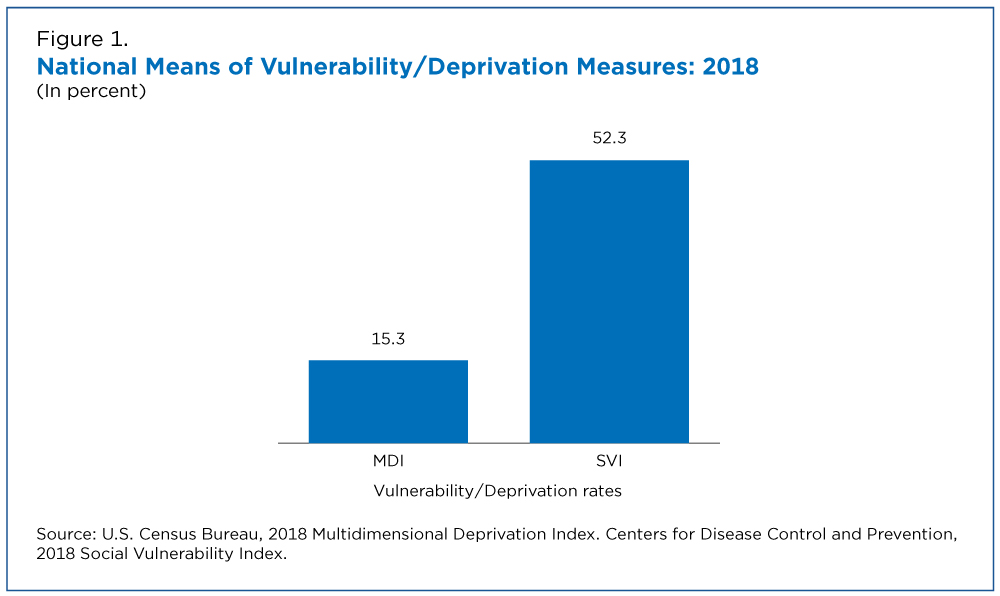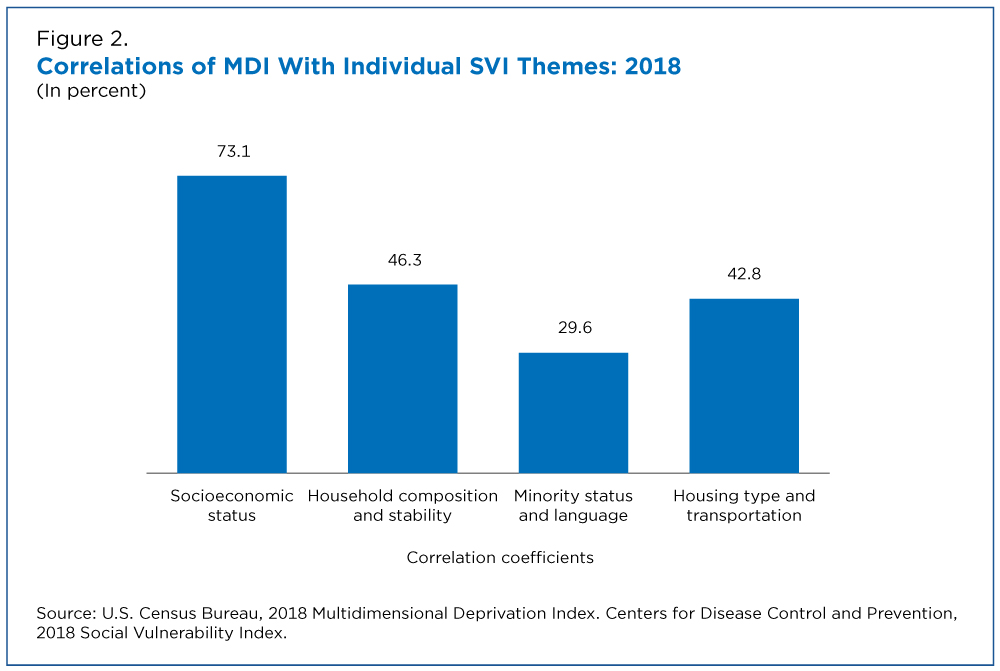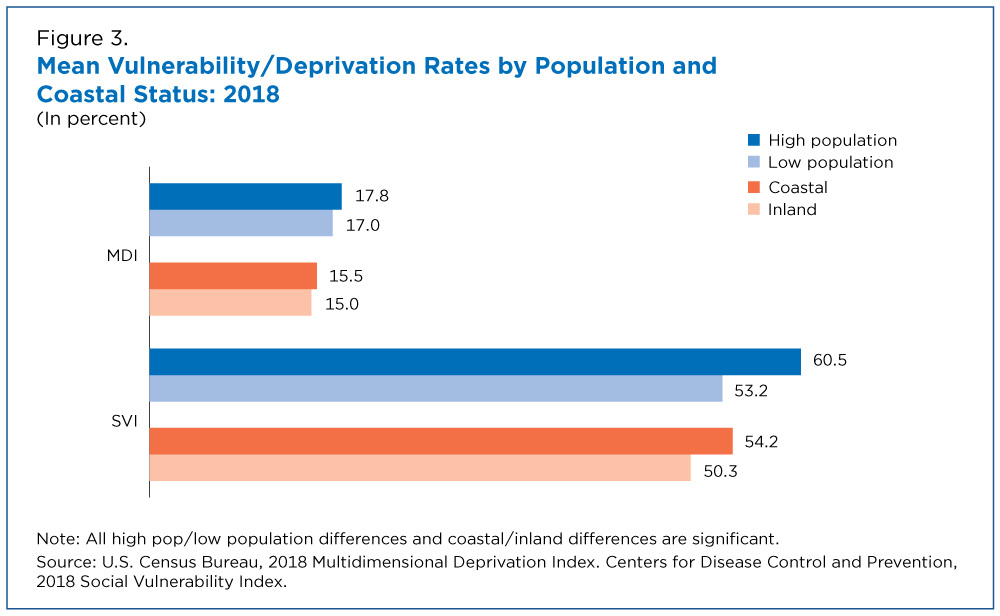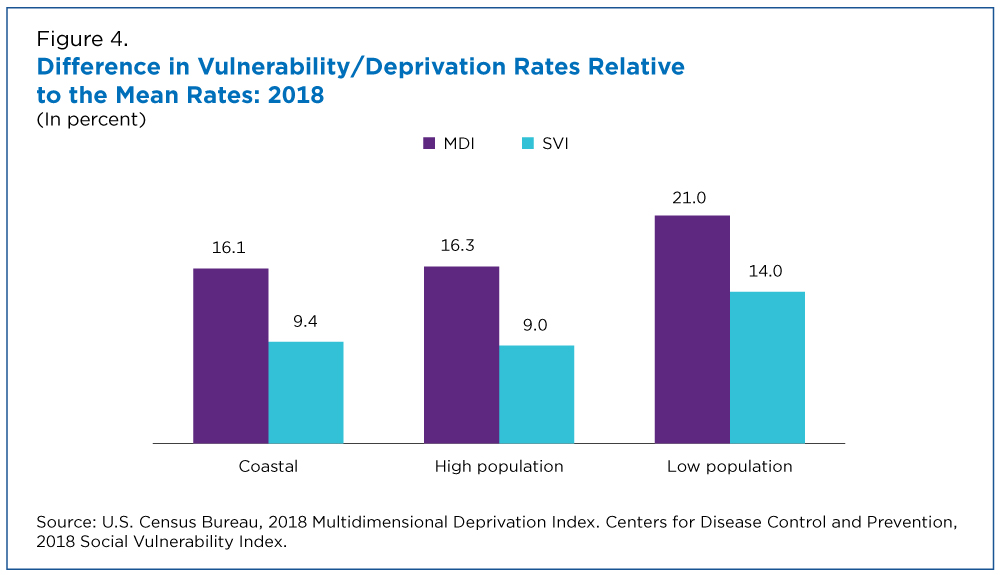By Two Government Measures, 526 Counties — Mostly in the South — Are Economically and Socially Deprived and Vulnerable
Government agencies, including the U.S. Census Bureau, have many ways to measure whether areas are deprived or vulnerable — important indicators of an area’s ability to withstand disasters and other challenges.
The Census Bureau analyzed two commonly used measures, the Social Vulnerability Index (SVI) and Multidimensional Deprivation Index (MDI), and found both showed the same 526 counties— mostly in the South — were most distressed.
By both measures, the rates were higher in counties with at least 1 million people (high population) than in counties with fewer than 65,000 people (low population).The measures also showed higher rates in coastal than inland counties.
The Centers for Disease Control (CDC) has been producing the SVI since 2000 to determine the social vulnerability of census tracts and counties. The Census Bureau for the past several years has released the MDI to assess the level of deprivation in sub-state areas.
Both measures use the Census Bureau’s American Community Survey (ACS) data. So how do they differ?
We explored these key questions:
- Which areas of the country did both measures identify as distressed?
- Were there areas where the measures showed different results?
- Were coastal counties more vulnerable?
- Did a county’s size influence its level of distress?
Overview of Two Measures of Distress and Deprivation
The CDC’s SVI is a measure of a community’s vulnerability in socioeconomic status; household composition and disability; minority status and language; and housing type and transportation.
The MDI is an index of deprivation in standard of living, health, education, economic security, housing and neighborhood.
Before comparing the measures, it is important to keep in mind their methodological differences:
- The MDI used 2018 ACS 1-year estimates and the SVI the 2018 ACS 5-year data.
- The MDI is based on microdata and the SVI on county aggregates.
- The MDI shows statistical uncertainty (by including standard errors or margins of error), the SVI does not.
Figure 1 shows national means of the two indexes.
The national average SVI rate was significantly higher than the MDI average rate but counties with high MDI rates of deprivation were also likely to have high SVI vulnerability rates (correlation rate of 71.1%). This means vulnerable counties also tended to be more deprived.
In Figure 2, correlations weighted by population are shown for the MDI with the four SVI measures. The MDI is most strongly related to socioeconomic status and least strongly to minority status and language.
Which Counties Rated High or Low by Both Measures?
In 526 counties or 16.7% of all counties, both measures showed high rates of vulnerability and deprivation (“all high”).
In 521 counties (16.6%), both measures showed low rates of vulnerability and deprivation (“all low”). In only 13 counties, one measure found high vulnerability or deprivation while the other found low vulnerability or deprivation.
Approximately 83% of the “all high” counties were in the South and 64% of the “all low” counties were in the Midwest.
County Size and Location Can Make a Difference
By both measures, the rates were higher in counties with at least 1 million people (high population) than in counties with fewer than 65,000 people (low population).
The measures also showed higher rates in coastal than inland counties (Figure 3).
Our analysis shows that when population size was constant, both measures were higher in coastal than in inland counties (Figure 4).
We can therefore conclude that coastal counties were more vulnerable and deprived than inland counties. When holding population size constant, there was a larger difference in rates between coastal and inland counties for the MDI (deprivation) than for the SVI (vulnerability).
Holding coastal status constant, both measures were higher in high population and low population counties than in counties with populations between 65,000 and 1 million.
The difference in deprivation rates in high population counties was higher for the MDI than for the SVI. In low population counties, the difference in deprivation rates was higher for the MDI than for the SVI.
The Census Bureau also releases another metric of neighborhood well-being, the Community Resilience Estimates (CRE). This article does not compare MDI or SVI to CRE because the CRE data released for 2018 was experimental and substantially revised between 2018 and 2019. However, analysis comparing CRE to SVI can be found in the working paper.
Subscribe
Our email newsletter is sent out on the day we publish a story. Get an alert directly in your inbox to read, share and blog about our newest stories.
Contact our Public Information Office for media inquiries or interviews.










